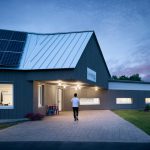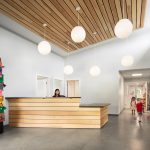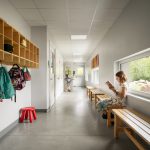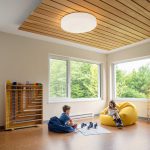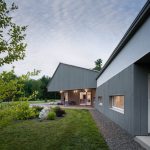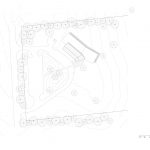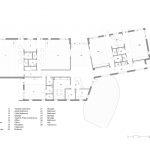What If Every School?
Project Name
What If Every School?, the first high-performance institutional or commercial building in Belfast, Maine, Cornerspring Montessori School’s new facility represents a milestone for both the school and the city. Combining a boldly contemporary form with subtle vernacular references, and encouraging a free flow of activity from indoors to outdoors, the building supports Montessori pedagogy while also following the stringent Passive House model of energy efficiency and indoor air quality. The result is an inspiring learning environment that also achieves the highest levels of comfort, health, and building durability. Requiring a fraction of the energy consumed by a conventional building, the new structure has dramatically reduced the school’s operating expenses, even as its distinctive profile has raised the institution’s visibility in the community.
The heart of the building’s single-story plan is a bar-like volume that contains the four elementary-grade classrooms, bending at its center to create a flexible common space. The classrooms line the building’s north-facing side, with large windows that deliver ample daylighting. Circulation spaces, administrative functions, and the toddler room occupy a smaller volume at the south, under a barn-like pitched roof that supports a 16kW photovoltaic array. In a contemporary nod to the archetypal rural schoolhouse, a dramatic cantilevered gable announces the building’s main entrance.
The building’s design is deeply informed by Montessori educational philosophy—which emphasizes independent learning, outdoor activity, and interaction among age groups—as well as by essential issues of accessibility, student safety, and building security. Each classroom comprises a sunny, flexible, self-contained learning environment with direct access to the outdoors. The four elementary classrooms and central gathering space can be combined in a variety of ways, facilitating multi-age activities, performances, and community events. The site, which includes two bio-swales to collect and filter surface runoff and more than 30 acres of wooded land for future trails, offers limitless potential for outdoor learning.
The new facility incorporates a super insulated, air-sealed Passive House building shell with R-50 walls, an R-100 roof, and triple-glazed windows—investments that were fully offset by consequent reductions in the size and complexity of the building’s mechanical systems. Decentralized air-source electric heat pumps provide supplemental heating and cooling, while a fully integrated heat-recovery ventilation system ensures a continuous supply of tempered fresh air. The result is a reduction in annual heating cost from $8,600 at the school’s previous location to near zero.
Measure 1: Design for Integration
What If Every School? occupies a 30 acre site in a natural setting on the outskirts of Belfast, Maine. Special attention was paid to enhance the existing landscape, rather than disturb it, while maintaining networked vehicular connection to the surrounding community. The project is located on a secondary road, providing easy access by car, foot, or bicycle.
Measure 2: Design for Community
The project was designed specifically through direct engagement with entire Cornerspring community: students, faculty, staff, and parents. The resulting design specifically speaks to the culture of community inherent to Montessori education.
Measure 3: Design for Ecology
The building’s siting and its engagement with the site’s natural contours minimized disturbance to the existing topography and vegetation. Landscaping is minimal, consisting largely of native woodland species and meadow grasses that require minimal inputs of energy and water. The presence of the building will have negligible impact on the site’s potential as wildlife habitat. Drives where designed as one directional to reduce impact through impervious surface and structure stormwater retention and filtration.
Measure 4: Design for Water
The project preserved all existing natural water flows on the site without disturbance. A relatively compact building form and minimal paved surfaces support the site’s capacity to manage rainwater and slow runoff.
Measure 5: Design for Economy
The project optimizes cost performance by making efficient use of space and by using durable, low-maintenance materials. The high performance building shell, including triple-glazed windows and doors and heat-recovery ventilation, reduces annual energy cost by approximately 80 percent, compared with conventional, code-compliant construction. Through strict adherence to this approach, this project was able to be executed below cost-points typically assigned to conventional construction, achieved largely through significant reduction in mechanical systems costs through adoption of Passive House principals at scale.
Measure 6: Design for Energy
The new facility incorporates a super insulated, air-sealed Passive House building shell with R-50 walls, an R-100 roof, and triple-glazed windows—investments that were fully offset by consequent reductions in the size and complexity of the building’s mechanical systems. Decentralized air-source electric heat pumps provide supplemental heating and cooling, while a fully integrated heat-recovery ventilation system ensures a continuous supply of tempered fresh air. The result is a reduction in annual heating cost from $8,600 at the school’s previous location to near zero.
After one and a half years of occupation, the measured energy-use including renewable energy production through photovoltaic panels illustrates an astounding improvement over similar conventional school buildings with a documents Energy Usage Index of 3.2 kBTU/SF/year.
Measure 7: Design for Wellness
The Passive House building shell maintains a stable and uniform temperature with minimal supplemental heating, providing a high degree of thermal comfort. Continuous, tempered, filtered ventilation maximizes indoor air quality. Fenestration provides ample, balanced daylighting, while minimizing harsh, low-angle sunlight. Materials and finishes were selected, to the greatest degree possible, to minimize VOC content throughout. Strong indoor-outdoor connections encourage physical activity through direct engagement.
Measure 8: Design for Resources
The building makes use of locally-sourced white pine paneling both interior and exterior (sourced within 20 miles of the project). Special attention was paid to construct the building from wood products to reduce embodied carbon impact. The standing-seam metal roofing is maintenance free, has a long service life, and is fully recyclable. The aluminum-clad windows and doors are pre-finished and require no finish maintenance.
Measure 9: Design for Change
The Passive House building shell affords a high degree of resilience to environmental stress or shock. In the event of an extended power outage, the building temperature will stabilize at far above freezing, remain habitable in reasonable comfort, and survive indefinitely without damage to its structure or systems. Drainage-plane construction detailing and multiple layers of weatherproofing allow the exterior walls sustain wetting and drying cycles without damage or performance degradation.
Measure 10: Design for Discovery
In its design process and its ongoing use, this project explores direct student and staff engagement with the surrounding 30-acre property through a didactic natural play space and connection to an on-site nature trail network.

